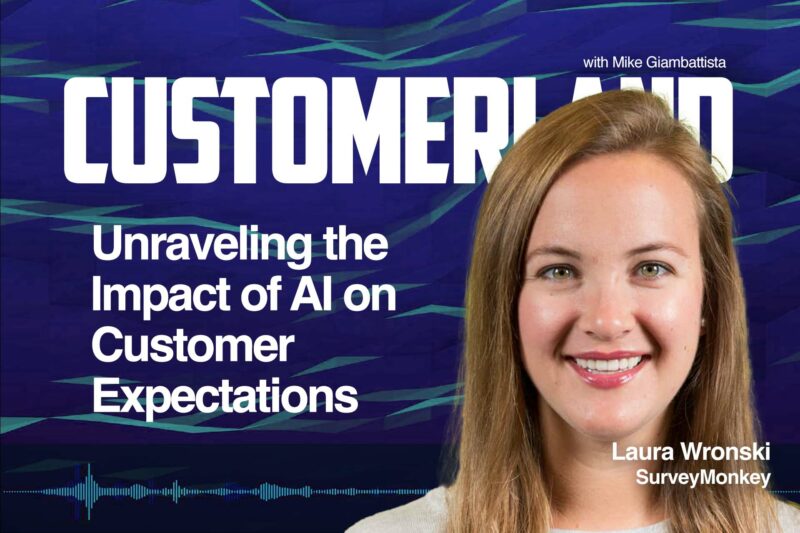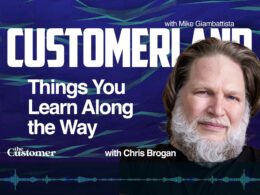Super enlightening discourse with Laura Wronski, the director of Research at SurveyMonkey – we dissect the State of CX report and the AI and the Customer Experience report. These reports are not just pages of data but they hold within them intriguing disparities between what CX and digital marketing professionals expect AI to contribute positively to customer service, and what customers actually expect. Laura also lifts the curtain on how the SurveyMonkey team is harnessing their platform to garner valuable insights that guide their decisions.
It’s no secret that customer expectations are skyrocketing but are the brands able to match up to them? As we move along, we dig deeper into this widening chasm between customer anticipations and brand deliverables. Borrowing insights from Laura, we put forth the concept of customer expectation audits – a strategic tool to bridge this gap and build an emotional connection with customers. We also attempt to unravel the potential of AI in customizing customer experience.
The final segment of our discussion brings into focus the stark differences in customer experiences when dealing with AI versus human customer service agents. Can you guess who was more likely to promote a brand? Hint: It’s not the AI. Yet, we also discover the areas where customers are more likely to lean towards AI – like getting personalized deals or understanding a product or feature. The debate of AI vs Humans in customer service is far from over, and this episode makes some compelling revelations. Tune in and join the conversation.
Full Transcript Below
Mike Giambattista
Today I have the pleasure of speaking with Laura Wronski, Director of Research at SurveyMonkey, formerly Momentive, formerly SurveyMonkey and back to SurveyMonkey again. Before we get into all that, and I think it’d be fun too, Laura, thanks for joining me. I really appreciate it.
Laura Wronski
Thank you so much, Mike. I’m really, really happy to be here.
Mike Giambattista
So there’s all kinds of news and we don’t have to go too deep into this, but let’s just talk about it a little bit. Recent announcement that you have a new CEO, eric Johnson, and, along with that, a return to your original brand name, which, because I know this is really important to your executives I’m in favor of. I think that was a smart move. Please let them know that I said so.
Laura Wronski
I agree.
Mike Giambattista
But there’s so much brand equity, there’s so much brand love. Everybody knew who you were, are and what you do and we’re all about, and the value brought to the table. So, all in all, I think it was a brilliant move. Plus, it’s just a fun name that sticks. So, yes, please let them know.
But beyond that, SurveyMonkey has put out a couple of reports recently that I believe you’re in charge of, Laura, putting all this stuff together. So who better to help unpack two specific reports, the titles of which are the state of CX emerging trends, challenges and opportunities?
And if you’re in the CX world or operate adjacent to the CX world, this is vital stuff and there’s some surprising data that came out of that. The other one is called AI and the customer experience the ups and downs and up and coming opportunities, and I don’t even need to talk about how vital this is right now because on everybody’s radar, everybody wants to know what’s what. But I thought one of the interesting things and we’ll touch on this later is how to use AI in ways that your employees and your customers actually like they don’t hate, which is a great angle, because people really ultimately want to know that Anyway. So, just for context, can you tell us about your role at SurveyMonkey, how you do what you do what you do there?
Laura Wronski
Yeah, of course. So I will say I joined SurveyMonkey back in 2015. So I’m very much in favor. You know, I think the SurveyMonkey brand is a strong one. We have a long history at this point of putting out interesting research and helping customers use our platform and our product to do whatever they’re trying to do. So if they’re CX professionals or HR professionals or market researchers, they will be able to find a way to use SurveyMonkey to pull together interesting insights that help inform their decisions.
I manage our research team. We are responsible for both kind of doing research that kind of demonstrates what you can do using our platform, but also we do research to help kind of move the product forward, develop new insights, you know, come up with interesting questions that we can ask ourselves. That will help create something like a state of CX industry report that helps CX professionals, you know, understand their own pain points, put that in reference to others, understand their customers pain points so that they can, you know, change up the way that they do things. And then we also, as part of our research team remit, we manage some external media partnerships and academic partnerships. So we work with media outlets like NBC, cnbc, wall Street Journal and others to field interesting. You know data on timely topics.
Oftentimes that might be something related to. You know the business decisions, the economy, politics, things that people are thinking about, and we’re always using the Survey Monkey platform to do that.
Mike Giambattista
Is that all you do there, okay?
Laura Wronski
That is what we do. Yeah, that’s right.
Mike Giambattista
That’s a lot. Well, let’s dig in a little bit into the state of CX report Is there? I think one overarching theme that I pulled out from the data was that there’s a massive disparity between what executives let’s just say them broadly executives think their customers know and want and expect, versus what their customers actually think and know and expect. And three specific data points here that are basically each one of them is a jaw dropper, I think, but I’m just gonna read them off here and then, if it’s okay with you, let’s just talk about what’s behind each one as we go. First one 63% of CX and digital marketing pros say that AI has a positive impact on their customer service. Only 25% of consumers expect AI to positively impact their experiences 63% of executives versus 25% of consumers. That’s a big disparity. That’s a big gap. What do you think’s behind that?
Laura Wronski
I mean, I think it’s one of those situations I think this happens in a lot of different circumstances right, businesses and professionals or experts in a certain field. They feel like they’re doing all this work, they’re putting all this effort, they’re spending all this time and resources on this one specific thing and they think it will immediately have an impact on their customer base or their audience or their employee base or whoever it is. So I think, in this particular context, that’s the disparity that we see that 63% of CX and digital marketing professionals expect AI to positively affect the customer experience. I would say 82% also say it’s a priority for their company. So this is the big thing that they are working on. But then does it actually translate to changing the customer experience? And maybe it might not be an immediate effect that takes place. So, as you said, 25% of consumers expect that AI to positively impact their engagement and 32% expected to have a negative effect on their engagement. So they’re not. It just doesn’t match up. They aren’t seeing the intent translate to direct consequences immediately.
Mike Giambattista
Yeah, and, to be fair, this is anticipated effects too, so you and I operate in this world, so to speak. We’re probably a little bit more familiar with what AI can do right now and have some view to what it could be doing in the near future. My sense is the average consumer just hears AI and may or may not be attuned to the negative press about it and whatever the media may be saying and hyping and, as part of media, I understand that, but so I get that to an extent. The surprising part of that to me, though, was that, whatever the statistic was 30, whatever percent, that was expected to have a negative effect on their experience.
Laura Wronski
Yeah. So I think as part of this survey we asked people to talk through some of their pain points that they have, or some situations where AI might be helpful to them and situations where AI would not be helpful. So for the most part, for CX in general, the good news from this report is that there is more optimism and more eagerness or willingness for consumers to interact with AI in the CX space versus, for example, the healthcare space or the education space or those sorts of industries. So more people said that they would be eager to interact with AI. If it’s going to help them return an item of clothing or help them get an answer to a question, then help them get a diagnosis. So in that side of things there’s some optimism.
But there are still a lot of complaints that consumers have about times when they’ve interacted with AI thus far. In a customer experience perspective. I think that original stat that you mentioned that kind of disparity between the optimism that professionals have and the pessimism that consumers have is probably due to the fact that CX professionals can kind of see around the corner a little bit. They know what’s coming and they know all of the things that are difficult for them to do in their jobs to incorporate all of this feedback from consumers all the time to kind of act quickly on my bill didn’t go through, or I paid, I said I paid and I didn’t, or vice versa, or whatever it is. And AI can act more quickly on that than a human can. And they know that the developments that are coming versus consumers are just thinking, oh, that one time when.
Mike Giambattista
I had to go to the chat box.
Laura Wronski
Yeah, that wasn’t great. I would rather just get someone on the phone, right, so that’s a tricky point.
Mike Giambattista
Yeah, and it would be interesting too I don’t know if you have this data but to find out. When you say AI in this context to a consumer, what are they thinking of? And maybe they’re, just, as you mentioned, just thinking of past experiences with a chat bot that were suboptimal because, let’s face it up until very recently they kind of all were. Many of them were.
Laura Wronski
Yeah, that’s true, yeah.
Mike Giambattista
Let me move on to another statistic. In 72% of CX and digital marketing pros say the level of customer experience their company provides rather has improved following the pandemic, and only 27% of consumers agree that one is kind of incontrovertible and there’s no. I don’t know how you can recontextualize that statement to make it anything but oops, there’s a disparity here, you know.
Laura Wronski
Yeah, I think one thing I would add onto that. So, yes, I think we’ve seen the impact of COVID. We’re three years away from March 2022, 2020. So we’re kind of all used to this new space, but it’s important to go back and think how did this affect the way that we deal with that?
We interact with brands that we’re buying from or companies that we’re working with or just how we go about our daily lives, and what this report shows is that there are still effects that are kind of trickling down from COVID, even three years later. So a stat that I would add onto the one that you shared is that 46% of consumers say their expectations for service and customer experience have remained the same, but if you ask CX professionals, more than about three and four, they customer expectations have increased as a result of COVID. So there’s this kind of it’s both sides that are kind of disagreeing on how much COVID has affected things. So CX professionals are saying, hey, everyone has much higher expectations of us now than they did in, say, December 2019, whereas at the consumer level you kind of don’t realize that. You just think like, oh, like I need an answer right now. You know like Amazon delivery tomorrow – I need this and it’s just kind of the new way of doing things. So we’ve gotten used to this heightened expectation that we didn’t have before.
Mike Giambattista
I was privy to some research a couple of months ago that analyzed customer expectations on a category by category basis, and what they did this is really interesting and I think, kind of fits here. What they did was they surveyed to create an ideal customer expectation set on a certain category, say automotive. If you are in the market to buy a car, you have certain expectations of how this could go. What does an ideal circumstance look like and what is sub that? And then they surveyed and evaluated brands and how they met those ideal expectations and their view was their data pointed to. What the CX professionals are saying is that consumer expectations are in fact increasing at an increasing rate, which effectively left brands in most categories with a widening gap between what those consumers expected in the category versus what the brand was able to provide Just kind of always increasing.
Laura Wronski
Yep.
Mike Giambattista
So, and you’re right, consumers don’t really see it because we’re them. You know it’s our growth. We can’t really see ourselves increase that way.
Laura Wronski
I mean, I think that’s exactly true. I think the data in this report bear that out as well. And I think from a consumer level you’re kind of constantly comparing each experience with the best experience that you’ve had. So you know, maybe before the standard was to not get a response from a company, you know, if you file a complaint or have a question for a few days, and now that just everything accelerates once one company can respond within minutes or hours, everything else compared to that becomes bad, you know. So, it’s just, it’s hard to keep up.
Mike Giambattista
It’s hard to keep up. Yep, you heard it right here from Laura Wronski. I mean she knows.
Sponsor Message
I want to take a quick break from the conversation to tell you about one of our sponsors. What could you achieve if you knew what your customers expected ahead of time? What if you could know what customers expect by category and by brand 12 to 18 months ahead of traditional brand tracking methods? And what if you could know exactly where to adjust and where to spend in order to drive the most benefit? Every time, a customer expectation audit allows you to identify areas that require strategic reinforcement, as well as pinpoint which values will contribute most to an emotional bond with your brand and optimize accordingly.
Customer land has partnered with brand keys, the world’s oldest loyalty focused consumer research firm, to bring real-world customer expectation audits to brands, brand managers and to CX. Practitioners everywhere Want to know where your brand stands and exactly what to do about it. Go to ExpectationAudit.com and download a sample audit today.
Mike Giambattista
86% of CX and digital marketing professionals say their customers receive a personalized experience all the most of the time, and yet this was the kicker only 8% of consumers feel they receive a consistently personalized experience. That’s a big disparity. That one indicates some serious failure on the part of CX professionals, and I don’t know how to tell that.
Laura Wronski
I think it gets back to. We talked at the beginning about how you can put all this work into your new email flow or a new website that you’re building. That will take people through the exact right path. But if it’s not the type of personalization that someone is looking for, if you build a new website but they really want to be able to get someone on the phone, it’s still not going to feel personal to them. So I think there’s still just this gap. I think it takes some time for these new behaviors to be built.
In the report, we include some examples of suggested ways to try to personalize your experience for people. So I actually think that there’s a lot of opportunity for AI to play a bigger role here, because you can get more creative and come up with new ways to personalize things. But leveraging your customer data and insights, personalizing promotions and discounts, really empowering your customer service team those are all some of our recommendations for how companies can take different types of initiatives through different channels that they have available to them to increase that personalization, and I think that what works for one company might not be the right solution for another.
Mike Giambattista
Right, I mean, it wasn’t that long ago that personalization just meant having your first name on an email.
Laura Wronski
Right, exactly, yeah.
Mike Giambattista
If that was ever effective, it was before my time. I mean old, but not that old. Yeah, and you’re right. Kind of along with the other topic we’re talking about was just expectations increase, and that’s the same for personalization expectations. We anticipate now being treated like we are the center of the conversation, which, as customers, we should be. If it’s okay with you, I’d like to turn the attention right now to the AI report.
Laura Wronski
Yeah.
Mike Giambattista
Yes, we’ve already talked about AI to an extent, but this one is is so timely and, in addition to serious amounts of water cooler topics that you can find here, it’s actually really important. If you’re a CX professional and again adjacent professions that deal and customer engagement, this is great stuff. It’s just great stuff. So I’m going to again start off with a killer stat. The impact of customer service chatbots on NPS and Tracy gave me the answer to your fault. Tracy, nps is 72 points higher for human service agents. Then it is for AI.
Laura Wronski
Right.
Mike Giambattista
And yet the entire investment community is running as fast as they can towards AI enterprises.
Laura Wronski
Yeah, so this was a fun one we tried to come up with. NPS is such a key metric for CX professionals right, so it’s. It’s the industry standard. It’s what everyone relies on to measure the success of not only their CX programs but put their business health overall. We really wanted to kind of tease out Can you measure the effect of having an AI versus a human handling? You know these CX questions, so we asked everyone who responded to the survey, thinking about the last time you interacted with a human and thinking about the last time you interacted with an AI customer service agent, how likely is it that you would recommend that company to a friend or colleague? So we have the same question, asked two different ways, of everyone, and that the NPS score for people who had interacted with it with an AI customer service agent was negative 66. Not a great NPS score.
Mike Giambattista
The score for those who interacted with the human customer service agent was a six, which is also not a great. Let’s be clear about that opportunity there.
Laura Wronski
Yes, but a lot of opportunity in both, but just the discrepancy there at these very early stages of let’s have AI being used in the in the CX world.
So you know, like let’s think about, in this particular example, if you are, you know, having a problem with your bank account and you are, you know, trying to use the chat function to to get an answer to, you know, whatever problem you’re dealing with, if you can tell it’s an AI, or if you know it’s an AI, you are much less likely to recommend that that bank that you’re working with than if you call someone and get a human on the phone and help them work through your problem with you, so that shows up, you know, in the NPS score itself.
Also say there’s a, you know, obviously a substantial difference in the promoter, the percentage of people who are promoters versus detractors, for each of those so for this, the respondents who answered the question about dealing with an AI customer service agent, just 10% of people ended up being promoters for that brand, versus 38% of promoters for when they got a human customer service agent. Similarly, 76% of people who thought about the time that they dealt with an AI customer service agent ended up being detractors versus 32% who ended up being detractors for humans. So I mean, obviously you can tell there’s going to be that big disparity just from the NPS score. I think that this there’s just a strong negative sentiment for the way that AI has been used for customer experience thus far, and that’s even relative to the fact that most of the time when people are dealing with the customer service that like you know it’s oftentimes a challenging experience.
Mike Giambattista
So there’s already lots of room for improvement there, right do you think that those, those data points have more to do with the fact that we’re talking about the realm of customer service which, you know, outside of customer service itself has a really negative perception overall?
Laura Wronski
I think thus far, the way that people are incorporating AI in their in their CX plans overall is mostly yeah, on the customer service sort of level. We did ask people in this report kind of different types of scenarios when they might be interested in having AI help them. So walking through a product, feature or website, finding personalized deals, resolving customer service issues. In general, there’s less enthusiasm for AI help on like resolving customer service issues and more on the kind of like the personalization aspect. So, like we talked about earlier, I think that’s where the real opportunity in AI is in the CX space is how do you create a flow for someone where they feel like they are getting this individualized attention and results, that it’s just for them, versus they are, you know, trying to solve this problem? That is just frustrating for everyone involved. So I think that’s where there is an opportunity.
Mike Giambattista
That’s going to be fun to watch and see how that develops. So in your report you’re able to uncover what you just call innovative AI use cases that customers are excited about. We’ve talked about what they’re not excited about. Where do you think customer excitement resides? Where is it pointing?
Laura Wronski
I think I mean there is a lot of opportunity in the CX world in general, right, so we have. I think I mentioned before in CX versus in medicine or in marketing, there is more desire to have AI be involved. So, for example, in our report we found that 69% of people say they would be uncomfortable using AI to get medical advice or how to invest their savings. However, 65% are comfortable with using AI to help with ordering food or beverages, which is kind of in the CX space, returning an item which is in the CX space in some cases. So like there’s some opportunity there. I would say more than kind of specific use cases or like industries or segments like that.
What we found is that when people are looking to interact with a human, they are more interested in having they have different priorities than when they say they’re willing to interact with an AI.
So when they are eager to interact with an AI, or the people who say that they would prefer to interact with an AI, 41% say that they think an AI has better availability than a human, 37% say that AI would be able to address their issues faster and 30% say it would be able to provide more accurate information than a human would. On the flip side, when people prefer a human over an AI they say 61% say it’s because a human understands their needs better, 53% say it’s because a human provides more thorough explanations, 52% say it’s because a human is less likely to frustrate me and 50% say a human gives me more options to address my issues. So it’s really just like they’re kind of mirror images of each other. If you prefer an AI, it’s because you value speed. You value the kind of the accuracy and the maybe lack of bias that an AI would provide. If you prefer a human, it’s because you’re looking for someone to kind of that empathy quotient that an AI. As far as missing that, you want someone who understands their needs.












